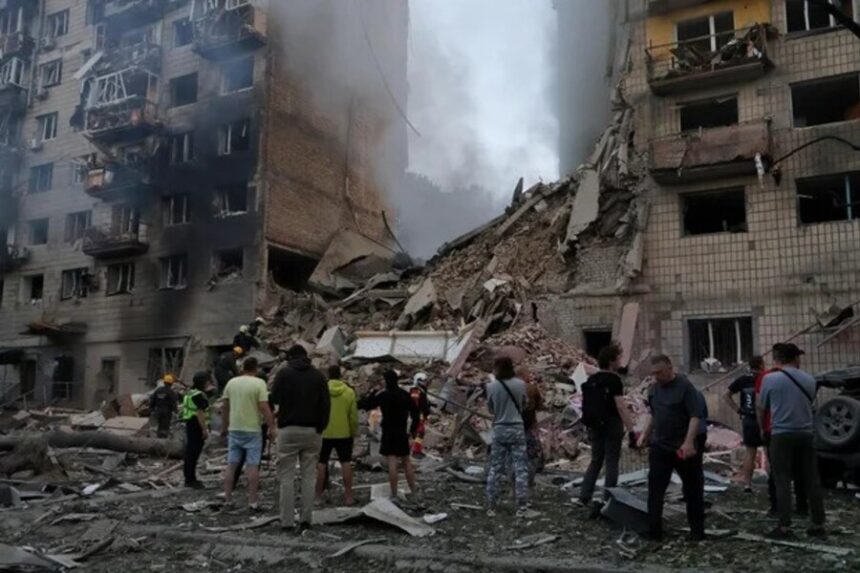A sustained Russian drone and missile attack on Ukraine’s capital late Monday into Tuesday killed at least 15 civilians, including an American citizen, and injured dozens more, according to Ukrainian authorities. The assault, which left entire apartment blocks gutted and families trapped beneath rubble, marks one of the most devastating strikes on Kyiv in recent memory as the war with Russia grinds into its third year.
The deadly overnight barrage coincided with the Group of Seven (G7) summit in Canada, where Ukrainian President Volodymyr Zelenskyy was scheduled to meet world leaders. While Zelenskyy condemned the assault as “pure terrorism,” the attack also served as a grim reminder of Russia’s intensified campaign to target civilian areas and infrastructure across Ukraine.
A Night of Horror in the Capital
According to Zelenskyy, the Russian military launched more than 440 drones and 32 missiles across Ukraine, with Kyiv absorbing the brunt of the damage. The bombardment lasted nearly nine hours, with explosions heard throughout the night across the capital.
Tymur Tkachenko, head of the Kyiv City Military Administration, described the destruction as catastrophic. A nine-story residential building was among the hardest hit, with 30 apartments obliterated after a ballistic missile plunged from the top floor to the basement. Emergency responders rushed to the scene to pull survivors from under debris, while fires blazed in multiple neighborhoods.
“There are 27 locations across the city that were hit,” said Interior Minister Ihor Klymenko. “We currently have over 2,000 personnel—rescuers, police, municipal services, and doctors—responding to the devastation.”
Kyiv Mayor Vitali Klitschko confirmed that the city’s Sviatoshynskyi and Solomianskyi districts were particularly affected, with fires breaking out in several areas from falling debris after air defenses intercepted part of the assault.
Among the dead was an American citizen, Klymenko confirmed, who succumbed to shrapnel wounds. The identity of the victim has not been publicly disclosed.
First-Hand Accounts of Devastation
Residents were caught off guard by the intensity of the attack. Olena Lapyshniak, 49, narrowly escaped death when explosions destroyed her apartment building.
“I heard a whistle, then two explosions,” she recalled. “My windows and doors blew out. It’s horrible—one moment there’s life, the next it’s gone. There’s no military infrastructure here, nothing. Just civilians dying at night.”
In total, local officials reported that 99 people were injured in the Kyiv attacks alone. Additional strikes in Odesa, a key southern port city, left one person dead and 17 injured, according to regional governor Oleh Kiper.
Strategic Timing and Global Attention
The assault came as the G7 summit got underway in Canada, where Zelenskyy was expected to lobby for increased support. However, a planned meeting with former U.S. President Donald Trump was disrupted after Trump departed early due to escalating tensions in the Middle East, the White House said.
Canada, currently holding the G7 presidency, had invited Zelenskyy to attend the summit to reinforce global solidarity with Ukraine. His participation was seen as crucial amid signs of war fatigue among Western allies.
Meanwhile, Russia’s recent escalation in missile and drone use follows a Ukrainian intelligence operation targeting Russian warplanes deep inside Russian territory. Analysts suggest the Kremlin’s intensification of attacks is part retaliation and part psychological warfare aimed at pressuring Ukraine’s civilians and leadership.
Broader Implications and Diplomatic Stalemates
Efforts at diplomacy continue to falter. Although direct talks in Istanbul have resumed, progress has been limited to prisoner exchanges scheduled for next week. “Little else has moved forward,” Zelenskyy admitted.
In a parallel development, Russian Security Council chief Sergei Shoigu traveled to North Korea for a second visit in less than two weeks, meeting with Kim Jong Un. Citing Russia’s state news agency Tass, Reuters reported that Shoigu was acting under “special instructions” from President Vladimir Putin, raising concerns over expanding military alliances amid the ongoing conflict.
Why This Matters
- Civilians remain the primary victims of Russia’s continued missile and drone assaults, with densely populated urban areas being routinely targeted.
- The death of an American citizen underscores the global impact and potential diplomatic consequences of Russia’s actions.
- The timing of the attack—as G7 leaders convene—raises questions about Moscow’s motives and the urgency of renewed international support for Ukraine.
- Escalating strikes across Ukraine suggest a shift in Russia’s tactics, potentially in response to Ukrainian efforts to hit strategic Russian military targets.
- Russia’s outreach to North Korea could signal new weapons or logistics arrangements, complicating the geopolitical landscape.
As Ukraine reels from the latest round of deadly strikes, the international community faces mounting pressure to bolster defenses and maintain diplomatic cohesion in the face of Russia’s widening aggression.




